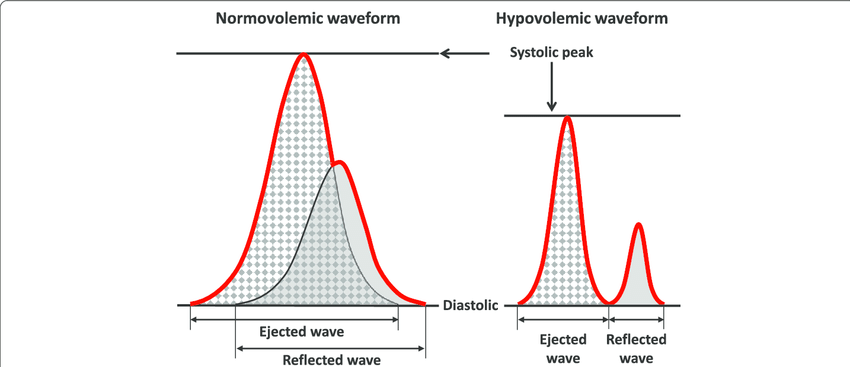What is Digital Product Development: 6 Stages You Need to Master
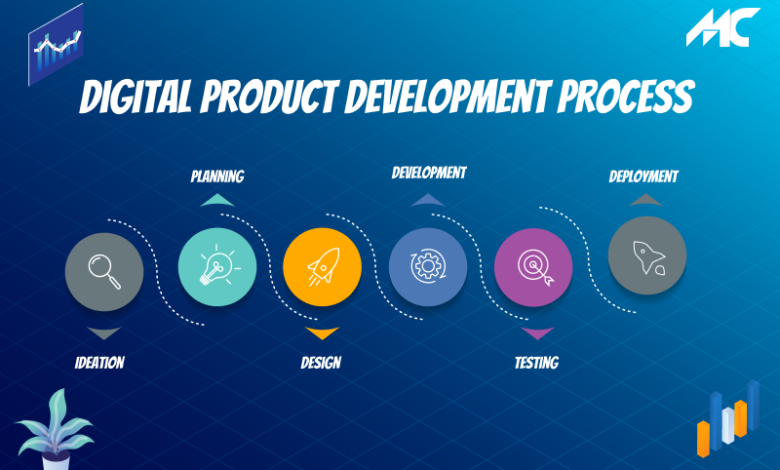
Digital product development is an essential aspect of successful businesses, as markets, competitors, and customer needs continuously evolve. Even established enterprises must adapt to stay competitive. The focus of digital product development is to create digital services that provide value to a wide range of people and meet their evolving needs.
What is Digital Product Development
Digital product development is the creation of software-driven user experiences that enhance an organization’s user journey. It utilizes agile methodologies to deliver products quickly and incorporates stakeholder input through frequent testing and iteration.
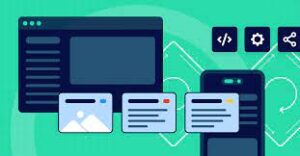
The stages of digital product development typically involve three key areas: the idea stage, the design and development stage, and the growth stage. These stages encompass various sub-stages performed by software development, product management, and product development teams. They may involve activities such as prototyping, quality assurance (QA) testing, and iterative improvements to ensure a successful product.
Digital product development encompasses the creation of software products, such as computer software, mobile apps, and websites. These products can encompass operating systems like Windows and Android, software programs like Word and Chrome, as well as various apps and websites.
The typical stages of digital product development include discovery, design, engineering, pre-release testing, and launch. Before these stages, product strategy and project shaping are carried out, while continuous product development follows the initial launch, forming an iterative cycle.
Keep this in mind when developing a digital product
- User insights are crucial for success, so actively gather and consider their feedback.
- It is acceptable for different teams to employ different project methodologies.
- Remain open to perspectives from all teams within the organization.
- A late but excellent product that meets user needs is more valuable than a timely but inferior one.
- Aligning product development with business goals is essential for success.
Digital product development mistakes to avoid
- Implementing a minimum viable product (MVP) can pose risks to your brand and long-term success.
- Avoid finalizing design elements too early, as anything created before the Design stage should be considered disposable.
- Preserve and value the knowledge gained from the shaping process if your team utilizes it.
- While UX Researchers are valuable, it is still possible to conduct valuable research even without a dedicated researcher.
- Continuously test and improve your product, and don’t cease these activities.
Digital product development focuses on creating enhanced user experiences through the development of digital products, including web pages, mobile apps, web apps, and digital dashboards. These code-based assets offer interactive value to users and aim to improve the customer journey. The process involves designing and developing digital products with a well-crafted user interface to optimize user engagement and satisfaction.
1. Idea Generation: The process starts with identifying a market need or opportunity and generating ideas for a digital product that can address that need or capitalize on the opportunity. This could be based on market research, user feedback, or innovative ideas.
2. Market Research: Before proceeding with development, it’s crucial to conduct market research to understand the target audience, competition, market trends, and customer needs. This helps in defining the product’s features, functionality, and unique selling points.
3. Conceptualization and Planning: In this stage, the product concept is defined, and a roadmap is created. The key features, functionalities, and user experience are outlined. The development team may create wireframes, prototypes, or mockups to visualize the product’s design and flow.
4. Design: The design phase involves creating the visual and user interface (UI) design for the product. This includes creating a visually appealing and intuitive interface that aligns with the product’s branding. User experience (UX) design principles are applied to ensure the product is easy to use and navigate.
5. Development: This is where the actual coding and development of the digital product take place. The development team uses programming languages, frameworks, and tools to build the software. Agile or iterative development methodologies are often used to ensure flexibility and adaptability throughout the process.
6. Testing and Quality Assurance: The developed product undergoes rigorous testing to identify and fix bugs, ensure functionality, and validate its performance. This includes functional testing, usability testing, compatibility testing, security testing, and performance testing.
7. Deployment and Launch: Once the product is thoroughly tested and meets the desired quality standards, it is deployed and made available to users. This involves hosting the product on servers, configuring infrastructure, and ensuring scalability and performance.
8. Post-launch Monitoring and Iteration: After the product is launched, it’s important to monitor its performance, gather user feedback, and analyze usage data. This information helps in identifying areas for improvement, adding new features, and addressing user needs through regular updates and iterations.
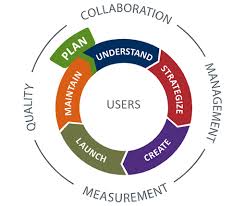
Digital Product Development Cycle
Indeed, the high-level workflow of building a digital product typically involves three major stages: ideation, design and development, and growth. These stages encompass activities such as brainstorming ideas, defining requirements, designing the user interface, coding and testing the product, and implementing strategies for user acquisition, retention, and continued product improvement.
Digital product development life cycle:
Ideation
During the ideation stage of digital product development, the focus is on identifying a problem and formulating a solution. This involves activities such as conceptualization, conducting research and analysis, making estimations, and validating the feasibility of the proposed digital product.
1. Vision
A strong vision statement captures the essence of a product and outlines its ultimate purpose. It can be concise and universal, such as Disney’s “To make people happy,” or insightful like Netflix’s “Helping content creators around the world to find a global audience.” The vision should emphasize the potential of the digital product and articulate long-term intentions.
2. Strategy
A well-defined product strategy guides the direction of the product team throughout implementation. Relying solely on inspiration is a common reason for startup failures. A successful strategy relies on a product roadmap that includes clear goals, success metrics, value proposition, competitive analysis, and other crucial data.
3. Research and market analysis
At the evaluation stage of digital product development, product owners need to:
- Analyze market trends and user needs
- Conduct feasibility studies and competitive analysis
- Determine the potential value and viability of the idea
- Make informed decisions on whether to proceed with the idea.
4. Budget
During the evaluation stage of digital product development, it is important to assess the available financial resources and forecast both short-term and long-term costs associated with the project.
5. Value proposition
During this stage, it is crucial to validate the viability of your digital product. The value proposition analysis involves identifying the benefits and drawbacks from the end-user’s perspective. This analytical approach can be facilitated using tools like the value proposition canvas. By conducting this analysis, you gain a comprehensive understanding of the functionalities and features needed by a specific user category.
6. Proof of concept
The proof of concept (PoC) is a crucial step to test the feasibility of a design concept. While some experts associate PoC with wireframing or prototyping, we consider it a pre-development stage as it determines if a digital product can be successfully built. Once the PoC confirms feasibility, the engineering phase can commence, bringing the product to life.
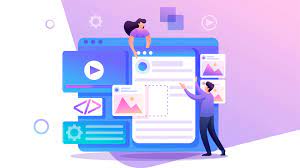
Digital Product Development Company
Nicheblink is a digital product agency that specializes in assisting businesses with digital product design and development. They offer a comprehensive range of services to help businesses integrate digital technologies into their operations. With a focus on customization, Nicheblink tailors their approach to each client, ensuring solutions are aligned with its strategic goals. Their expertise includes creating adaptable websites, mobile apps, e-commerce platforms, and other digital assets that meet the expectations of today’s consumers. With a team of dedicated professionals, NicheBlink aims to equip businesses with the latest digital resources to stay competitive in the dynamic digital landscape.
Digital Product Development Services
- UX Design: Creating an exceptional user experience for your digital product.
- UI Design: Designing an attractive and user-friendly interface that complements the UX.
- Prototyping: Developing interactive prototypes with seamless navigation for testing and validation.
- Branding: Designing a distinctive visual style that represents your digital product.
- Design Systems: Establishing a cohesive and comprehensive design language, style, and documentation for consistency across digital products.
- Research: Conducting market, user, and competitor research to validate hypotheses and inform decision-making.
- Additional services: Offering a range of supplementary services such as marketing strategy, video production, social media marketing (SMM), pay-per-click (PPC), and more.
Digital product development agency
A digital product development agency is a company that specializes in providing services related to the creation and development of digital products. These agencies typically have a team of professionals who possess expertise in various disciplines such as product strategy, design, software development, quality assurance, and project management. They work closely with clients to understand their business goals, target audience, and requirements to deliver high-quality digital products.
Digital product development agencies offer a range of services to support the entire product development lifecycle, including:
- Product Strategy: Assisting in defining the product vision, identifying market opportunities, and creating a roadmap for development.
- User Experience (UX) Design: Designing intuitive and user-friendly interfaces through wireframing, prototyping, and user testing to ensure a positive user experience.
- User Interface (UI) Design: Creating visually appealing and engaging interfaces that align with the brand identity and enhance usability.
Digital product development agencies are experienced in working with diverse clients across various industries, and they leverage their expertise and resources to deliver innovative and successful digital products that meet client objectives and user needs.
See Also:




